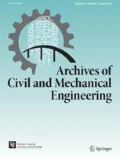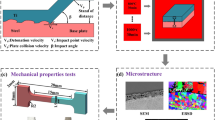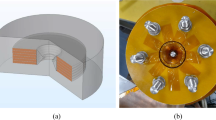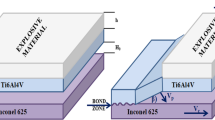Abstract
In this work, an improved explosive welding technique was introduced to obtaining high-quality metal coatings, where titanium (TA2) foils with different thicknesses of 0.1, 0.2, 0.3, and 0.4 mm were successfully coated on Q235 steel. Systematic investigations of the achieved claddings were conducted using macro- and micro-morphology observations, EDS elemental analyses, mechanical tests (three-point bending and nanoindentation), and electrochemical measurements. It was concluded that the explosive welding technique was an effective way to produce high-quality TA2 coatings. In both morphological analyses and mechanical tests, an excellent bonding quality was confirmed for the cases of TA2 foils with a thickness of greater than 0.1 mm. Meanwhile, the welding window was proved still being practical for predicting the bonding interface characteristics in the explosive welding of the metal foil. The EDS analyses and nanoindentation tests signified inhomogeneous properties of the materials near the bonding interface due to shock-induced work hardening and the formation of molten zone. Eventually, TA2 foil coatings were certified by electrochemical measurement to remarkably enhance the corrosion resistance of the Q235 substrate.








Similar content being viewed by others
Availability of data and materials
The raw/processed data required to reproduce these findings cannot be shared at this time due to technical or time limitations.
References
Price TS, Shipway PH, Mccartney DG. Effect of cold spray deposition of a titanium coating on fatigue behavior of a titanium alloy. J Therm Spray Technol. 2006;15:507–12.
Kawakita J, Kuroda S, Fukushima T, Katanoda H, Matsuo K, Fykanuma H. Dense titanium coatings by modified HVOF spraying. Surf Coat Techol. 2006;201:1250–5.
Majzoobi GH, Nemati J, Rooz AJN, Farrahi GH. Modification of fretting fatigue behavior of AL7075–T6 alloy by the application of titanium coating using IBED technique and shot peening. Tribol Int. 2009;42:121–9.
Kim SC, Jo WL, Kim YS, Kwon SY, Cho YS, Lim YW. Titanium powder coating using metal 3D printing: a novel coating technology for cobalt–chromium alloy implants. Tissue Eng Regen Med. 2019;16:11–8.
Blazynski TZ. Explosive welding, forming and compaction. New York: Elsevier; 1983.
Bataev IA, Tanaka S, Zhou Q, Lazurenko DV, Junior AJ, Bataev AA, et al. Towards better understanding of explosive welding by combination of numerical simulation and experimental study. Mater Des. 2019;169:107649.
Manikandan P, Hokamoto K, Fujita M, Raghukandan K, Tomoshige R. Control of energetic conditions by employing interlayer of different thickness for explosive welding of titanium/304 stainless steel. J Mater Process Tech. 2008;195:232–40.
Mousavi SAAA, Sartangi PF. Experimental investigation of explosive welding of cp-titanium/AISI 304 stainless steel. Mater Des. 2009;30:459–68.
Chu Q, Zhang M, Li J, Yan C. Experimental and numerical investigation of microstructure and mechanical behavior of titanium/steel interfaces prepared by explosive welding. Mater Sci Eng A. 2017;689:323–31.
Gloc M, Wachowski M, Plocinski T, Kurzydlowski KL. Microstructural and microanalysis investigations of bond titanium grade1/low alloy steel st52-3N obtained by explosive welding. J Alloys Compd. 2016;671:446–51.
Mousavi SAA, Sartangi PF. Effect of post-weld heat treatment on the interface microstructure of explosively welded titanium–stainless steel composite. Mater Sci Eng A. 2008;494:329–36.
Hokamoto K, Nakata K, Mori A, Tsuda S, Takuya T, Inoue A. Dissimilar material welding of rapidly solidified foil and stainless-steel plate using underwater explosive welding technique. J Alloy Compd. 2009;472:507–11.
Sun W, Li X, Yan H, Hokamoto K. Effect of initial hardness on interfacial features in underwater explosive welding of tool steel SKS3. J Mater Eng Perform. 2014;23:421–8.
Zhou Q, Feng J, Chen P. Numerical and experimental studies on the explosive welding of tungsten foil to copper. Materials. 2017;10:1–16.
Liu WD, Liu KX, Chen QY, Wang JT, Yan HH, Li XJ. Metallic glass coating on metals plate by adjusted explosive welding technique. Appl Surf Sci. 2009;255:9343–7.
Yang M, Ma H, Shen Z, Huang Z, Tian Q, Tian J. Dissimilar material welding of tantalum foil and Q235 steel plate using improved explosive welding technique. Mater Des. 2020;186:108348.
Yang M, Ma HH, Shen ZW. Study on explosive welding of TA2 titanium to Q235 steel using colloid water as a covering for explosives. J Mater Res Technol. 2019;8(6):5572–80.
Koch A, Arnold N, Estermann M. A simple relation between the detonation velocity of an explosive and its gurney energy. Propellants Explos Pyrotech. 2002;27:365–8.
Blazynski TZ. Explosive welding, forming, and compaction. New york: Elsevier Applied Science; 1983.
Aceves SM, Loza FE, Elmer JW, Huber R. Comparison of Cu, Ti and Ta interlayer explosively fabricated aluminium to stainless steel transition joints for cryogenic pressurized hydrogen storage. Int J Hydrog Energy. 2015;40:1490–503.
Godunov SK, Deribas AA, Zabrodin AV, Kozin NS. Hydrodynamic effects in colliding solids. J Comput Phys. 1970;5:517–39.
Yang M, Ma HH, Yao DM, Shen ZW. Experimental study for manufacturing 316L/CuCrZr hollow structural component. Fusion Eng Des. 2019;144:107–18.
Du S, Wang S, Ding K. A novel method of friction-diffusion welding between Ti/Al alloy and GH3039 high temperature alloy. J Manuf Process. 2020;56:688–96.
Yu Y, Xu PB, Li K, Zhao J, Dai YT, Ma HH, et al. Study on modalities and microdefects of Al–Cu bimetallic tube by underwater explosive cladding. Arch Civ Mech Eng. 2019;19:1–9.
Bina MH, Dehghani F, Salimi M. Effect of heat treatment on bonding interface in explosive welded copper/stainless steel. Mater Des. 2013;45:504–9.
Zhang T, Wang W, Zhou J, Yan Z, Zhang J. Interfacial characteristics and nano-mechanical properties of dissimilar 304 austenitic stainless steel/AZ31B Mg alloy welding joint. J Manuf Process. 2019;42:257–65.
Zhou SF, Zhao Y, Wang XJ, Li W, Chen DC, Sercombe TB. Enhanced corrosion resistance of Ti-5 wt.% TiN composite compared to commercial pure Ti produced by selective laser melting in HCl solution. J Alloy Compd. 2020;820:153422.
Qiang YJ, Zhang ST, Guo L, Zheng XW, Xiang B, Chen SJ. Experimental and theoretical studies of four allyl imidazolium-based ionic liquids as green inhibitors for copper corrosion in sulfuric acid. Corros Sci. 2017;119:68–78.
Gai X, Bai Y, Li J, Hou WT, Hao YL, et al. Electrochemical behavior of passive film formed on the surface of Ti–6Al–4V alloys fabricated by electron beam melting. Corros Sci. 2018;145:80–9.
Vasilescu C, Drob SI, Neacsu EI, Rosca JCM. Surface analysis and corrosion resistance of a new titanium base alloy in simulated body fluids. Corros Sci. 2012;65:431–40.
Salavand Z, Amirnasr M, Talebian M, Raeissi K, Meghdadi S. Enhanced corrosion resistance of mild steel in 1 M HCl solution by trace amount of 2-phenyl-benzothiazole derivatives: Experimental, quantum chemical calculations and molecular dynamics (MD) simulation studies. Corros Sci. 2017;114:133–45.
Funding
The reported research is supported by China Postdoctoral Science Foundation (2020M682028), the Fundamental Research Funds for the Central Universities (WK5290000001, WK2480000007, WK2480000008,2320000049), the opening project of Shock and Vibration of Engineering Materials and Structures Key Laboratory of Sichuan Province (18kfgk09), and the China National Nature Science (51874267).
Author information
Authors and Affiliations
Contributions
MY and HM designed the experiments, JX and BZ conducted the experiments, DC and JT carried out the characterization tests, JX and ZS analyzed the data, and MY and JX wrote the manuscript.
Corresponding authors
Ethics declarations
Conflicts of interests
We declare that we do not have any commercial or associative interest that represents a conflict of interest in connection with the work submitted.
Additional information
Publisher's Note
Springer Nature remains neutral with regard to jurisdictional claims in published maps and institutional affiliations.
Rights and permissions
About this article
Cite this article
Xu, J., Yang, M., Chen, D. et al. Providing a new perspective for obtaining high-quality metal coatings: fabrication and properties studies of TA2 foil on Q235 steel by explosive welding. Archiv.Civ.Mech.Eng 21, 118 (2021). https://doi.org/10.1007/s43452-021-00271-x
Received:
Revised:
Accepted:
Published:
DOI: https://doi.org/10.1007/s43452-021-00271-x




